September 27, 2023
The accelerated advancement of artificial intelligence (AI) and subsequent emergence of large language models (LLMs) at scale are combining to redefine the job landscape in the technology sector.
Super-charged by new tools and products – such as GitHub’s Copilot, Midjourney and ChatGPT – significant labour market shifts are expected amid considerable economic and geopolitical upheaval.
“Generative AI is poised to impact labour markets significantly but this impact will be highly different across different roles,” said Saadia Zahidi, Managing Director of World Economic Forum.
“Business leaders, policy-makers and employees must collaborate on harnessing the potential of new jobs while managing displacement and ensuring a future of work that empowers and elevates people.”

According to World Economic Forum findings – Jobs of Tomorrow: Large Language Models and Jobs – more than two thirds (68%) of all technology roles will be severely exposed to the continued advancements in AI. Within this context, LLMs are expected to either entirely replace or enhance human productivity in the coming years.
Specifically, approximately 32% of all technical roles within the industry are considered as having “high potential for automation”, defined as a task that will be performed by LLMs and not humans going forward.
The majority of jobs (36%) will be augmented rather than automated however – humans will continue to perform the task but LLMs will increase human productivity.
To generate such estimates, the exposure rating measured all occupations within a particular industry, averaging and weighting by total employment while taking into account that occupations may belong to more than one sector.
Only two industries held higher estimates of total potential exposure through automation and augmentation than the technology sector, both of which are housed within the financial services vertical – financial services and capital markets, and insurance and pension management.
“Industries with high potential for exposure to LLMs have high potential for both automation and augmentation,” the report stated. “This suggests that introducing these new technologies will change the nature of the labour market but will not necessarily reduce the total number of jobs.”
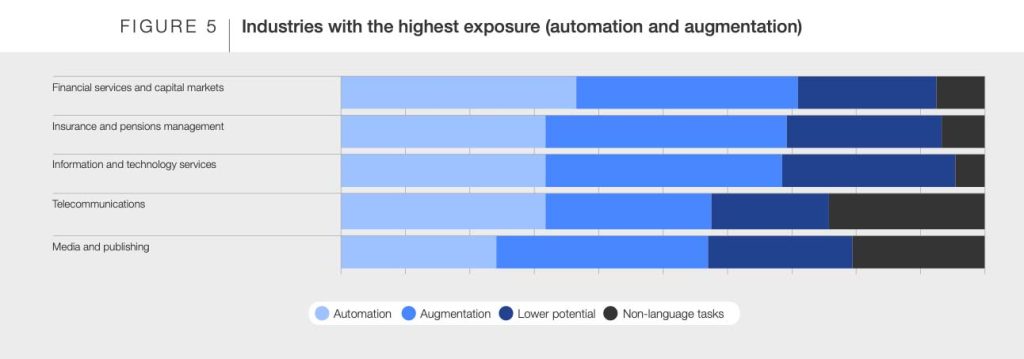
Identifying exposed vs. non-exposed jobs
Methodologies deployed by the World Economic Forum aimed to identify which tasks are expected to be exposed to LLMs and how they will be subsequently impacted. This could be in the form of direct replacement via automation or enhancement through augmentation.
On that basis, exposure was classified into four categories:
The report outlined an example of an exposed vs. non-exposed job, referencing software developers in comparison to human resource managers.
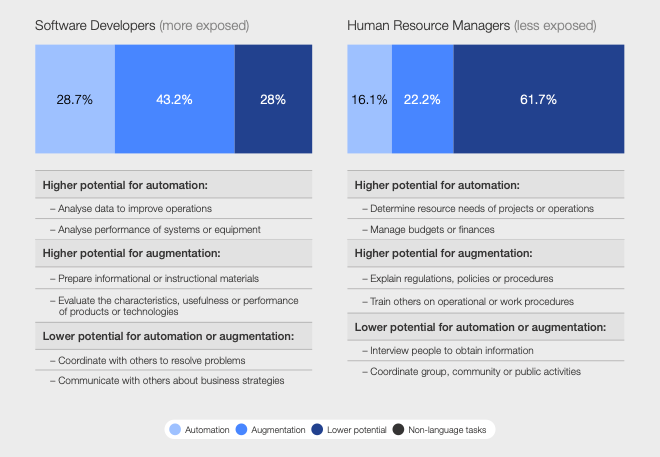
The purpose of the research is to examine how LLMs and deep-learning algorithms that “recognise, summarise, translate, predict and generate content using very large datasets” can affect current and future jobs.
“LLMs could be a boon for jobs that require critical thinking, complex problem-solving skills and creativity, including those in engineering, mathematics and scientific analysis,” Zahidi outlined.
“These tools could benefit workers by increasing the productivity of routine tasks and making their roles more rewarding and focused on a higher added value.”
On the flip side, the jobs most at risk of automation – with up to four-fifths of the tasks automated – are those that involve routine and repetitive language tasks, including roles such as credit authorisers, checkers and clerks.
The analysis examined more than 19,000 distinct tasks across 867 different occupations likely to be impacted by LLMs.
AI impact on tech jobs
Based on World Economic Forum findings, the two sectors with the greatest total potential exposure to LLMs are IT (73% of work time exposed) and finance (70% of work time exposed).
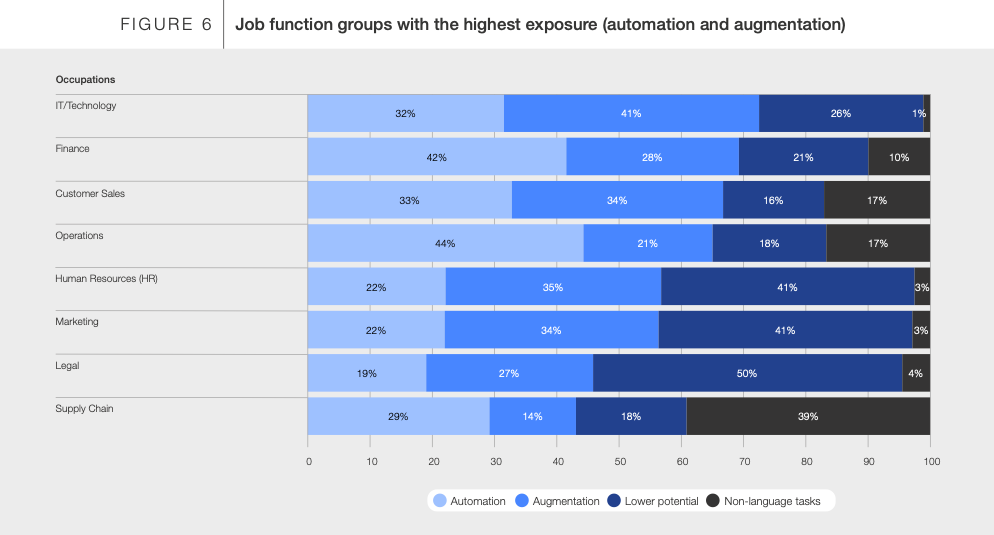
Research stressed that job functions likely to be automated also tend to have a high chance of being enhanced or augmented by technology, and vice versa.
“This is an important counterpoint to the notion that technological innovation displaces jobs: technological innovation transforms jobs, with some tasks being eliminated and others becoming more important,” the report stated.
The most exposed jobs within the technology industry centre around the computer networking space – chiefly support and system administration roles – as well as within software quality assurance.
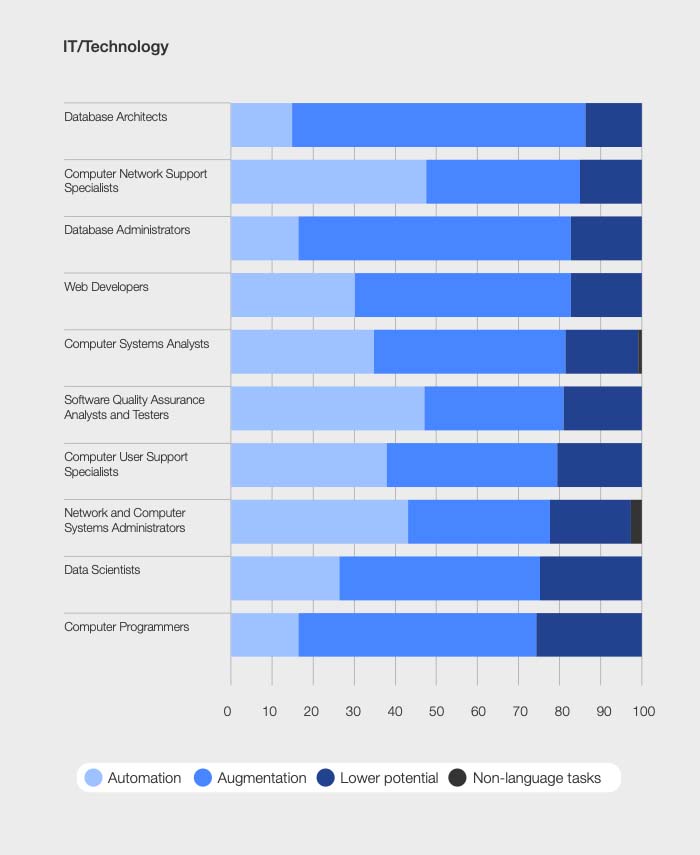
This new data on the impact of LLMs supplements and reinforces the findings from the World Economic Forum’s Future of Jobs Report 2023, which predicted that 23% of global jobs will change in the next five years due to industry transformation.
Primarily, this will be through AI and other text, image and voice processing technologies.
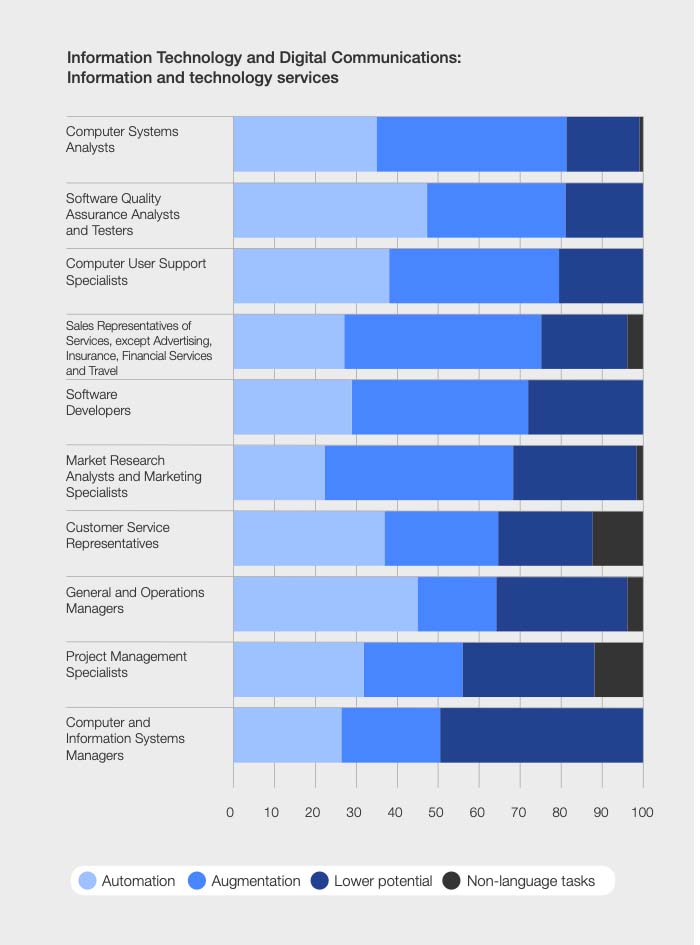
Many of the jobs found to have high potential for automation by LLMs are expected to undergo employment decline within the next five years.
“Rather than leading to job displacement, LLMs may usher in a period of task-based transformation of occupations, requiring proactive strategies to prepare the workforce for these jobs of tomorrow,” Zahidi added.
For Zahidi, it will be incumbent upon businesses and governments to take “proactive steps” in preparing the workforce for the imminent transformation to ensure that “all members of society benefit from the potential” of generative AI.
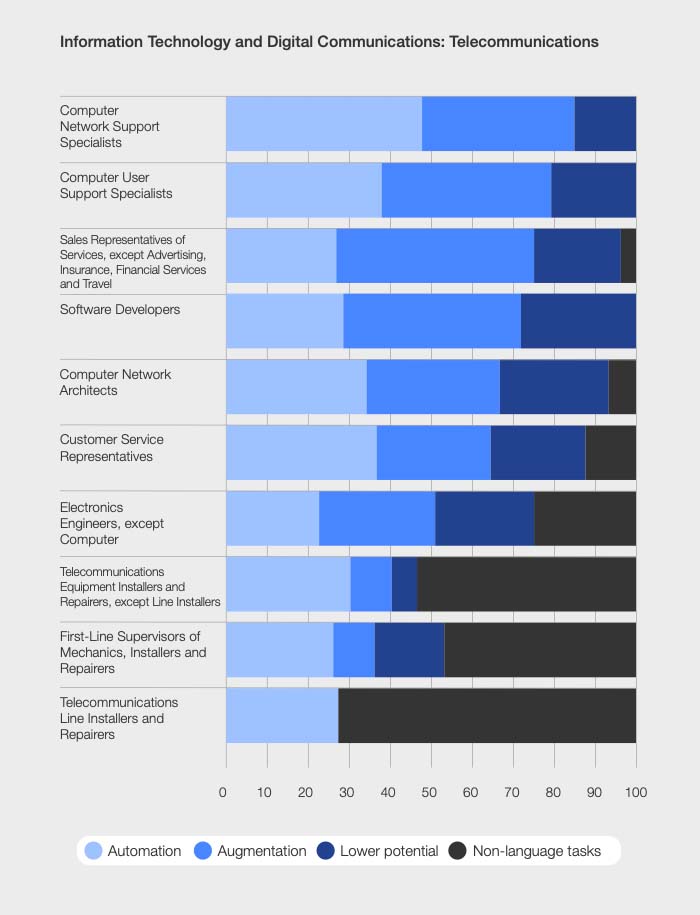
New AI roles emerge
Despite the obvious impact on certain job functions within the technology sector, as LLMs advance, new roles will also be created.
According to findings, this includes AI developers, interface and interaction designers, as well as AI content creators, data curators and specialists in AI ethics and governance.
While no predictions can be 100% certain regarding which new roles may appear with the widespread adoption of LLMs, Zahidi claimed it’s apparent that there is room for job development in several key areas.
Specific to AI model and prompt engineers, engineers and scientists will continue developing and fine-tuning LLMs at the most detailed level of AI systems innovation.
These jobs will cover the range of programmers designing more efficient algorithms and electrical engineers designing custom chips to train and run the models. This is in addition to systems administrators building server infrastructure and infrastructure and power systems engineers ensuring these systems have the stable energy sources needed for extended runs.
On the topic of interface and interaction design – and according to World Economic Forum – completed and trained LLMs are still highly technical and will require well-crafted interfaces to be accessible to the public. In some ways, this position can be considered as user experience (UX) designers for LLMs.
This family of jobs will be responsible for crafting LLMs to adapt to a particular kind of user input (for example, typing or spoken voice) or to perform particular tasks, such as in the development of personalised AI assistants, tutors or coaches.
In the context of ethics and governance specialists, the presence of prejudiced or other unsavoury language in training data can lead LLMs to produce biased, harmful or unethical content. Not only will training data need to be checked for quality, but trained LLM systems will need to be rigorously tested before being released to the public.
This will fall into the purview of specially trained AI safety officers and ethicists at the company level and even domain-specific regulators and lawyers at the government level.
Inform your opinion with executive guidance, in-depth analysis and business commentary.